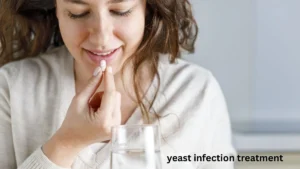Introduction: Understanding Yeast Infections in 2025
Vaginal yeast infections, medically known as vaginal candidiasis, remain one of the most common fungal infections among women. According to the CDC, 3 out of 4 women will experience at least one yeast infection in their lifetime. While treatable, yeast infections can become recurrent and significantly affect a woman’s quality of life.
In this 2025 expert-reviewed guide, we explain the latest yeast infection treatment options, prevention tips, and new developments like the NXT-2 vaccine, designed to prevent recurring cases.
Reviewed by Dr. Aisha Mehra, OB-GYN and Women’s Health Specialist, Fortis Healthcare, Mumbai.
What is a Yeast Infection?
A vaginal yeast infection occurs when there’s an overgrowth of the Candida fungus, most commonly Candida albicans. This fungus naturally exists in the body but becomes problematic when the vaginal microbiome is disrupted.
Common Symptoms Include:
- Intense vaginal itching or irritation
- White, cottage cheese-like discharge
- Burning sensation during urination or sex
- Vaginal redness and swelling
While not considered an STI, sexual activity and hormonal changes can increase risk.
How Are Yeast Infections Diagnosed?
Healthcare providers may perform:
- A pelvic exam
- A vaginal swab to identify fungal overgrowth
- pH testing to rule out bacterial infections
Dr. Mehra recommends avoiding self-treatment unless you’re certain it’s a yeast infection. Misdiagnosis can delay effective treatment.
Read more: Gastroesophageal reflux disease treatments Guide 2025: Symptoms, Options, Costs & Innovations
Yeast Infection Treatment Options (2025)
1. Over-the-Counter (OTC) Antifungals
Mild cases can be treated with OTC antifungal products like:
- Clotrimazole (Canesten)
- Miconazole (Monistat)
- Tioconazole (Vagistat)
These come in cream, suppository, and ointment forms and typically work within 1–7 days.
2. Prescription Antifungals
For moderate to severe cases, or recurrent infections, doctors may prescribe:
- Fluconazole (Diflucan) – Oral tablet taken once
- Terconazole (Terazol) – Stronger vaginal cream
- Butoconazole (Gynazole) – Prescription suppository
Note: Fluconazole is not recommended during pregnancy.
Treatment During Pregnancy
Pregnancy alters hormone levels, making yeast infections more likely. Oral antifungals are generally avoided.
Safe Treatments Include:
- Topical clotrimazole or miconazole
- Prescription creams only under doctor supervision
Dr. Mehra explains: “Pregnant women should only use medications recommended by their gynecologist. Topicals are usually safe, but oral antifungals may carry risks.”
Home Remedies: Do They Work?
Some women use natural remedies for symptom relief. While not clinically proven, a few have anecdotal support:
- Plain yogurt (with probiotics): Helps restore vaginal flora
- Coconut oil: Has antifungal properties when applied externally
- Tea tree oil: May work topically, but must be diluted and patch-tested
Always consult a healthcare provider before trying home remedies.
Read more: Lice Treatment Guide 2025: Symptoms, Options, Costs & Prevention
Recurrent Yeast Infections (RVVC): What to Know
When you experience 4 or more yeast infections in a year, you may have Recurrent Vulvovaginal Candidiasis (RVVC).
Possible Causes:
- Hormonal imbalances
- Antibiotic overuse
- Diabetes
- Weakened immunity
Treatment Plan May Include:
- 6-month antifungal regimen
- Lifestyle adjustments
- Dietary changes and probiotics
Yeast Infection Treatment Medicine List
| Medicine Name | Type | Active Ingredient | How to Use | Availability |
|---|---|---|---|---|
| Fluconazole (Diflucan) | Oral Antifungal | Fluconazole | Single 150 mg tablet orally | Prescription / OTC (USA) |
| Miconazole (Monistat) | Topical Antifungal | Miconazole Nitrate | Cream or suppository (1, 3, or 7-day) | Over-the-Counter (OTC) |
| Clotrimazole (Gyne-Lotrimin) | Topical Antifungal | Clotrimazole | Cream or vaginal tablet (3 or 7-day) | OTC |
| Terconazole (Terazol) | Prescription Topical | Terconazole | Vaginal cream or suppository | Prescription Only |
| Butoconazole (Gynazole-1) | Prescription Topical | Butoconazole | Single-dose vaginal cream | Prescription Only |
| Tioconazole (Vagistat-1) | OTC Topical | Tioconazole | One-day ovule or ointment | OTC |
| Boric Acid Suppositories | Natural/Alternative | Boric Acid | Vaginal suppository, 1 daily for 7-14 days | OTC (with caution) |
| Nystatin | Prescription Topical | Nystatin | Vaginal tablet (used rarely today) | Prescription Only |
| Probiotic Suppositories | Natural Support | Lactobacillus strains | Daily for flora balance | OTC / Health Stores |
| NXT-2 Vaccine (Upcoming) | Preventive Vaccine | Protein-based (pan-fungal) | Under clinical trials (not yet public) | Expected 2026+ |
Notes:
- Pregnancy: Oral medications like Fluconazole are not recommended during pregnancy. Use only topical antifungals.
- Recurrent infections: Boric acid or prescription-strength creams may be more effective.
- Doctor consultation is essential if symptoms persist, worsen, or if this is your first yeast infection.
Prevention Tips for 2025
- Wear breathable cotton underwear
- Change out of wet clothes quickly
- Avoid scented soaps and douches
- Take probiotic supplements or eat yogurt
- Maintain balanced blood sugar levels (especially for diabetics)
Breakthrough in 2025: The NXT-2 Yeast Infection Vaccine
Researchers from the University of Georgia recently announced the NXT-2 vaccine, the first of its kind targeting fungal infections, including recurrent yeast infections.
Key Points:
- Effective in mice and moving to human trials
- Protects against Candida albicans
- May drastically reduce recurrence rates
- Especially beneficial for immunocompromised patients
According to Karen Norris, Ph.D., lead scientist:
“NXT-2 fills a gap in fungal infection prevention. Drug resistance is growing—this vaccine offers hope.”
The vaccine is expected to enter Phase 1 clinical trials for women with RVVC in late 2025.
When to See a Doctor
Seek professional help if:
- Symptoms last beyond 7 days
- Infections recur frequently
- You’re pregnant
- You notice unusual symptoms like foul odor, bleeding, or fever
Delaying treatment can lead to complications like secondary bacterial infections or misdiagnosis of other conditions.
Yeast Infection Myths vs. Facts
| Myth | Fact |
|---|---|
| Only women get yeast infections | Men can also develop genital yeast infections |
| Poor hygiene causes them | Over-cleaning can disrupt the natural flora |
| You don’t need to treat them | Untreated infections may worsen |
| Cranberry juice cures yeast infections | It helps UTIs, not fungal infections |
Conclusion: Take Charge of Your Vaginal Health
Yeast infections are uncomfortable but highly treatable. Whether you opt for OTC creams, prescription pills, or anticipate the NXT-2 vaccine, managing symptoms effectively begins with awareness and early intervention.
With more treatment options in 2025 and expert medical guidance, there’s no need to suffer in silence. Stay informed, act quickly, and always consult a healthcare provider for the best results.
FAQs
Q1: How long does treatment take to work?
OTC creams typically clear infections in 1–7 days. Oral meds may work faster.
Q2: Is it safe to treat yeast infections at home?
Mild cases, yes—but consult a doctor if you’re pregnant or unsure of the diagnosis.
Q3: Will the NXT-2 vaccine replace antifungal medication?
Not immediately. It aims to prevent recurrent infections, not treat acute ones.
Q4: Can men get yeast infections?
Yes. Symptoms include redness, itching, and discharge from the penis.





